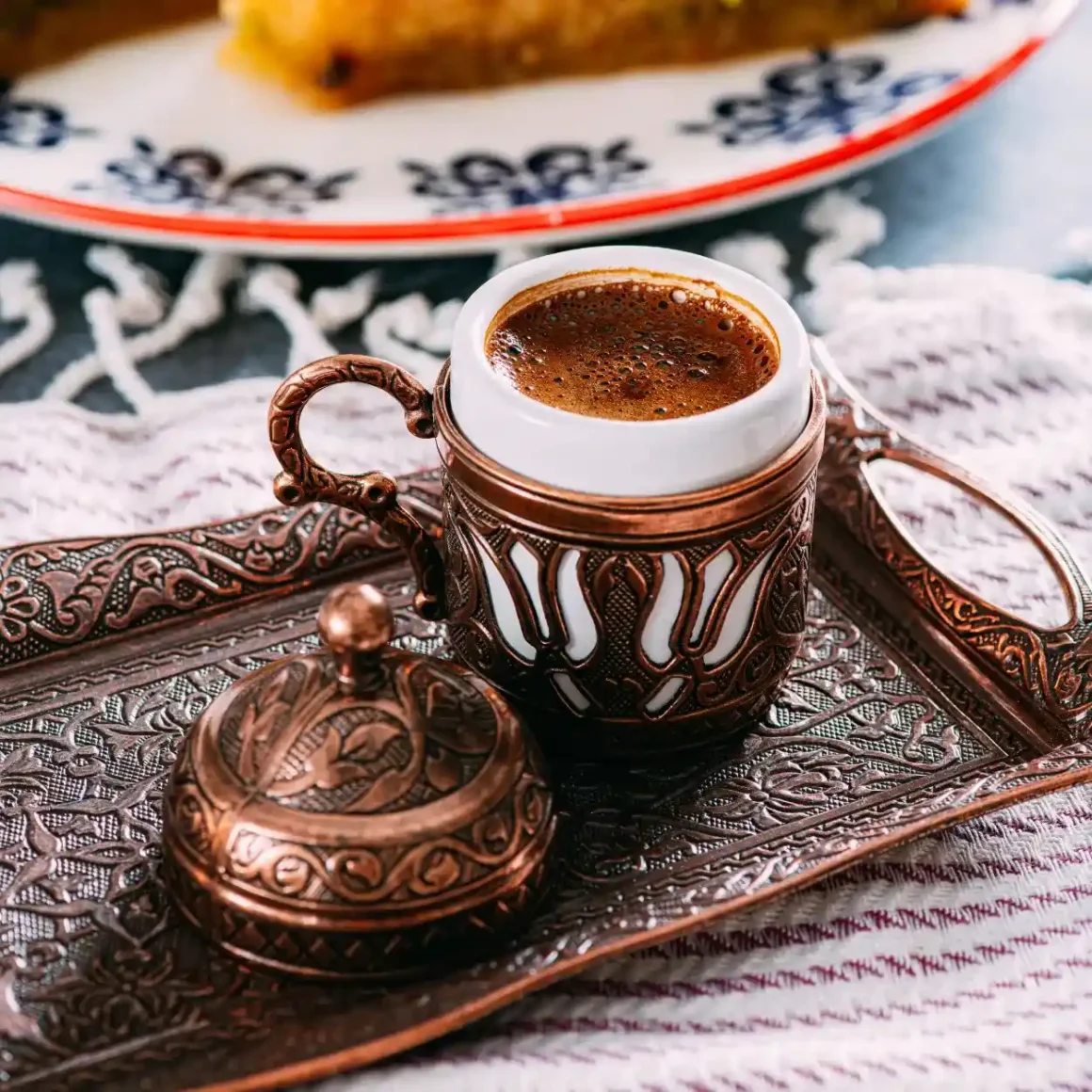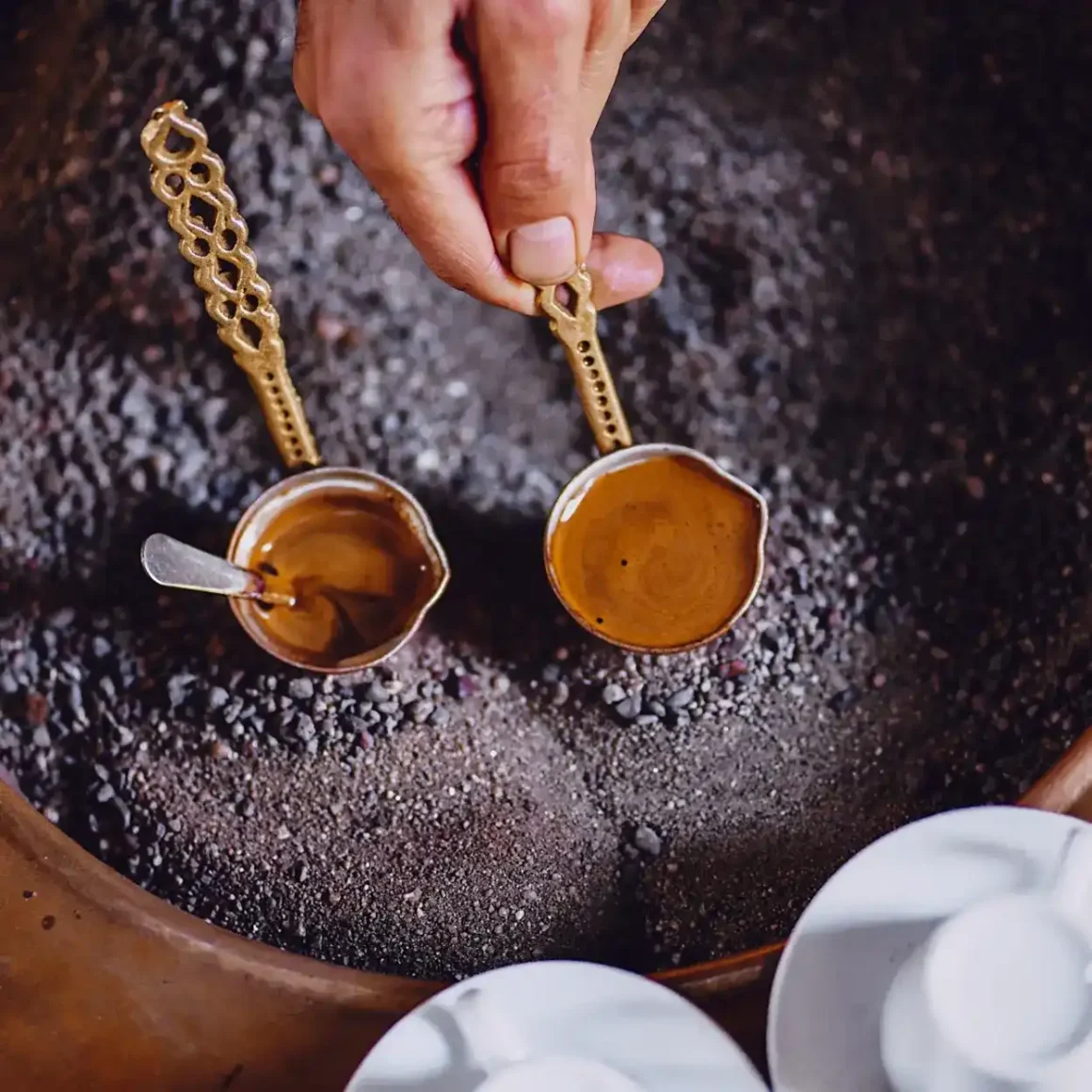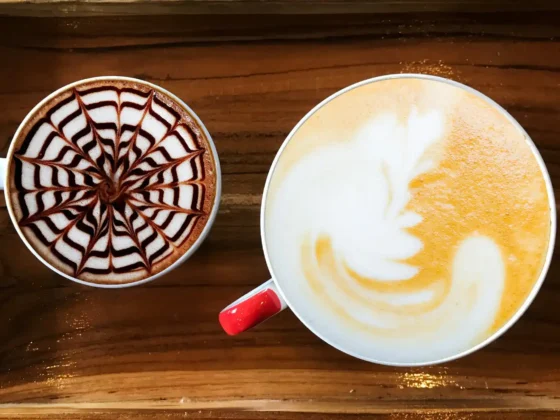Delve into the rich, aromatic world of Armenian coffee—a unique beverage that’s more than just a morning pick-me-up. This intricate brew holds a special place in Armenian culture, often serving as the centerpiece for social gatherings and even traditional fortune-telling rituals. In this exploration, we’ll guide you through its distinct preparation techniques, from the choice of finely ground beans to the signature brewing vessel known as a jazwa.
Understand the flavors that make it an unmissable experience, paired often with delightful Armenian pastries like Baklava or Kunafa. Learn the nuances that set it apart from other global coffees, and pick up some insider tips to enhance your own coffee-drinking moments. Whether you’re a coffee aficionado or a curious beginner, prepare to deepen your appreciation for this flavorful, social, and deeply cultural beverage.
Armenian Coffee: Key Takeaway
- Cultural Significance: Armenian coffee is deeply rooted in the nation’s traditions, serving not just as a drink but as a medium for social connection, communal gatherings, and even a touch of mysticism with fortune-telling rituals.
- Preparation Method: The coffee is made using a distinct brewing vessel, the jazwa, and is traditionally served in petite cups, kalkals. The preparation process and serving method set it apart from other coffee varieties.
- Flavor Profile: Offering a robust and sugary taste, Armenian coffee beans undergo extended roasting, resulting in an intense, full-bodied flavor. Additions like sugar, cardamom, or cinnamon enhance its rich profile.
- Pairings & Experience: Armenian coffee is frequently accompanied by sweet treats like Baklava or Kunafa. It’s not just about the taste; it’s about savoring the moment, making it a deeply social and cultural experience.
- Storage and Freshness: To enjoy Armenian coffee at its best, understanding the ideal methods of storing coffee is crucial. This ensures that every brew captures the authentic taste and aroma that Armenian coffee is renowned for.
What is Armenian Coffee?

Armenian coffee is a specialized coffee beverage characterized by its intense, full-bodied flavor and aromatic richness. Crafted through time-honored techniques passed down through generations of Armenians, it is traditionally known as սուրճ (pronounced ‘soorj’) in its indigenous language.
The preparation involves the use of finely ground coffee beans brewed in a small specialized pot, commonly known as a jezve or cezve. While the method of making this coffee aligns with practices in various Balkan and Mediterranean countries, a unique aspect lies in the specific way it is ordered. Enjoyed globally, particularly in regions with a significant Armenian community, this coffee is often featured in special ceremonies and notable occasions.
History of Armenian Coffee
Armenian coffee has a rich and complex history, weaving itself into the very fabric of Armenian culture and traditions over the years. It’s not just a beverage, but a cultural emblem that has seen various evolutions.
The Origins: When Armenia Met Coffee
The intricate relationship between Armenia and coffee is an intriguing tale that dates back centuries, underscoring the beverage’s significance in Armenian culture. Here’s a closer look at this relationship:
Armenian Influence on Corfu’s Coffee Scene
The rich taste of what’s known today as “eastern coffee” in Corfu can be traced back to Armenian settlers who introduced this distinct coffee variety to the island. Unlike many regions that embraced Ottoman coffee culture due to Ottoman rule, Corfu’s coffee culture was primarily shaped by Armenians, as the island was never under Ottoman influence.
Armenia’s First Coffee Venture in Europe
Venturing into the annals of coffee history, one finds an Armenian entrepreneur pioneering the introduction of coffee in Europe. In 1674, a time when the allure of coffee was just starting to spread across the Western world, this entrepreneur set up one of the earliest coffee establishments, as cited in The Reuben Percy Anecdotes compiled by Thomas Byerley.
Terminology and Preparation in Armenian Tradition
- Naming the Brew: In Armenia, this beloved drink is often referred to as “հայկական սուրճ” or “haykakan surč,” translating to ‘Armenian coffee.’ Another popular term is “սեւ սուրճ” or “sev surč,” which means ‘black coffee.’ The name underscores the traditional method of preparation, where milk or creamer is eschewed, retaining the coffee’s original dark hue.
- Sugar and Tradition: If you’re in Armenia and prefer your coffee without sugar, you’d order it as “bitter” or “դառը” (daruh). However, in a more conventional setting, the brewing process often sees the inclusion of a touch of sugar, imparting a subtle sweetness to the otherwise robust brew.
In essence, the intersection of Armenian tradition and coffee has led to a unique blend of culture and taste, making Armenian coffee an integral part of the country’s identity and heritage. (1)
Coffee in Armenian Traditions

In Armenia, coffee is more than a caffeinated beverage; it’s an integral element of social interaction and familial bonds.
- Home Rituals: If you’re a guest in an Armenian home, the tradition dictates that you’ll be offered a hot cup of coffee.
- Social Fabric: Coffee acts as a medium for casual conversation, sharing stories, and reinforcing community ties.
- Special Occasions: The drink is often served during significant life events and ceremonies.
In short, the serving of coffee has evolved to become a cornerstone of Armenian culture, exemplifying hospitality and togetherness.
The Evolution of Armenian Coffee Culture
The culture surrounding this coffee has seen transformations but has remained rooted in its core principles of social engagement and heritage.
- Espresso Era: During the time Armenian traders opened the first coffee houses in Europe, espresso was primarily served, capturing the essence of social congregations.
- Global Popularity: Armenian coffee has gained international recognition, particularly in places with a significant Armenian demographic.
- Modern Interpretations: While the traditional methods remain, new forms and variations of making this beverage have emerged, adapting to modern tastes.
Thus, the enduring legacy of Armenian coffee encapsulates its journey from historical origins to becoming a global phenomenon, all while staying true to its cultural significance.
How to Make Armenian Coffee: The Art of Brewing
The act of making Armenian coffee is an ancient ritual that offers a window into the country’s rich history and traditions. Just like most Middle Eastern nations, Armenia has its particular spin on the coffee-making process, a ritual that has endured for over a thousand years. From the finely ground coffee beans to the special pot used for brewing, each element has its purpose, and each step is critical for achieving the perfect cup.
Choosing the Right Beans

When it comes to making exquisite Armenian coffee, your choice of beans is paramount. In Armenia, coffee beans are ground into a nearly powdery texture to achieve the unique flavor profile of the brew.
- Imported Beans: Given that Armenia doesn’t produce a large number of coffee beans, many are imported, primarily from Colombia. Quality is key; so choosing beans from a reliable source ensures an authentic experience.
- Flavor Variants: The fine ground coffee you choose may also be labeled differently depending on the country of purchase. For instance, the same grind could be sold as Armenian, Greek, Turkish, or Lebanese coffee. Lebanese versions might even include cardamom, offering an entirely different, but equally enjoyable, taste.
By taking the time to select the right beans, you set yourself up for a flavorful and traditional Armenian coffee experience.
The Role of the Jezve (Coffee Pot)

Central to the art of brewing Armenian coffee is the use of a specialized Armenian coffee pot known as a ‘jezve’ and also ‘srjep’ This unique piece of cookware is more than just a tool; it’s a symbol deeply embedded in the country’s culture.
- Design and Material: Jezves are typically handcrafted, often made of copper, featuring a distinct U-shape that aids in the brewing process. The shape and material contribute a magical touch to the coffee’s final taste.
- Availability: If you find yourself in Armenia, it’s highly recommended to acquire a jezve, which you can readily find at home goods stores or the Vernissage Markets in Yerevan. An antique, Soviet-era jezve can even serve as an incredible souvenir.
The jezve is not just a cooking implement; it is an intrinsic part of the tradition and hospitality that defines Armenian culture.
Perfecting the Brewing Process

Creating the perfect cup of Armenian coffee is a labor of love that demands attention to detail. The brewing process may seem simple, but it’s nuanced, requiring precise actions at each stage.
- Measurements: Exact measurements of coffee, sugar, and water are essential. The components are then placed in the jezve, stirred to combine, and the spoon is removed to allow for proper crema formation.
- Heating: The jezve is placed on low heat, and what follows is a lesson in patience. As the brew heats, it begins to rise slowly. The challenge lies in removing it from heat just before it boils over, which is the key to preserving its rich flavor and crema.
- Serving: The final act involves delicately pouring the coffee into a cup, maintaining the integrity of the crema. Now, you’re ready to invite a friend over and pair your coffee with a delectable Armenian pastry, like gata.
Knowing how to make Armenian coffee involves more than following a recipe; it’s about embracing a time-honored tradition that celebrates the Armenian way of life.
The Cultural Significance
Armenian coffee is not just a beverage; it’s an intricate tapestry woven into the fabric of the nation’s culture and traditions. The humble cup of coffee serves as a tool for social bonding, a medium for divination, and a symbol of hospitality. As we delve deeper into its varied roles, we’ll explore how this seemingly simple drink shapes social life, fortune-telling traditions, and modern-day household customs in Armenia.
Coffee and Armenian Social Life
In Armenia, coffee plays an extraordinary role in social engagements. Unlike ordinary coffee savored in solitude, Armenian coffee thrives when it becomes a communal experience.
- Social Catalyst: As previously discussed, Gathering around a table to enjoy Armenian coffee often serves as an impromptu social event, reinforcing familial bonds and friendships. It’s an invitation to pause, connect, and share a moment together.
- Time of Day: Though the late morning is a popular time for these coffee gatherings, the fluidity of Armenian culture allows for enjoyment at any time, defying strict schedules.
- Conversations: The act of drinking coffee is often accompanied by meaningful conversations, catching up on life, or even discussing pressing community matters.
In a nutshell, this coffee acts as a cornerstone in social life, facilitating conversations and connections that might not happen otherwise.
Reading Coffee Grounds: Fortune Telling and Beyond

Armenian coffee is not merely consumed; it’s studied for what lies at the bottom of the cup. This practice, although less prevalent than before, continues to fascinate those interested in divination.
- Methodology: After consuming the coffee, one twists the cup counter-clockwise to let the remaining grounds form patterns along the sides and bottom of the cup.
- Interpreters: Typically, it’s the older generation—often grandmothers endowed with a knack for interpretation—who read these patterns, unearthing key insights about one’s future or present circumstances.
- Symbols and Meanings: Distinct figures often emerge, such as animals or shapes. A horse might symbolize an unfulfilled desire, while a bird could signify upcoming exciting news. (2)
Beyond its delightful taste, Armenian coffee cups serve as canvases for storytelling and foresight, linking the drinker to a heritage of mysticism and symbolism.
The Coffee Tradition in Modern Armenian Households
The cultural significance of Armenian coffee extends to contemporary households, where both tradition and innovation coexist.
- Accessibility: With the advance of globalization, this coffee has become more accessible. It’s easier than ever to procure quality Armenian coffee and prepare it at home, even if you’re not in Armenia.
- New Flavors and Techniques: Younger generations are experimenting with different blends and preparation techniques, infusing new life into an age-old tradition.
- Preserving Culture: Despite modern influences, the ritualistic aspects of preparing and enjoying this coffee continue to be respected, preserving a slice of Armenian identity.
As traditional meets modern, this coffee remains a steadfast pillar in homes across the country, bridging the past and the present in each aromatic cup.
Comparing Armenian Coffee to Other Brews
In the diverse world of coffee, each culture brings its own unique touch to the cherished beverage. Understanding the nuances between Armenian coffee and other popular forms of coffee can enrich your appreciation for this ubiquitous drink. In this section, we will delve into the distinctions and similarities that set Armenian coffee apart from Turkish coffee and espresso, and discuss how Armenian coffee has made its unique mark on a global scale.
Differences between Armenian and Turkish Coffee

Armenian coffee and Turkish coffee share a historical and geographical intimacy, making them similar yet distinct in various ways.
- Preparation Method: Both are made using finely ground coffee beans, but the specific technique may vary. For instance, Armenian coffee is typically made in a special pot known as a jazwa, whereas the Turkish version uses a pot called a cezve.
- Serving Style: This coffee is generally served in small, lidded cups called kalkals. Turkish coffee, on the other hand, is served in similar but not identical cups without lids.
- Flavor Profile: While both types of coffee are known for their robust flavor, Armenian coffee often includes a sugary element. Turkish coffee tends to be more diverse in its flavor additions, using spices like cardamom more frequently.
- Cultural Context: In Armenian households, coffee is usually a post-meal treat, whereas in Turkish culture, coffee can be a part of various ceremonies and social gatherings.
To sum it up, although Armenian and Turkish coffees are close cousins, they each have unique attributes that differentiate them from each other, from the pots and cups used to the cultural context in which they are enjoyed.
Armenian Coffee vs. Espresso: A Texture and Flavor Analysis

Armenian coffee and espresso are two different realms of the coffee universe, each boasting unique characteristics.
- Texture: One of the most noticeable differences is the texture. This coffee is known for its sediment settling at the bottom of the cup, while espresso is generally smoother with a layer of crema on top.
- Flavor Depth: This coffee has a rich and sugary taste profile, often further enhanced by additional spices. Espresso, by contrast, is generally more focused on the purity of the coffee bean’s flavor.
- Serving Size: Espresso is typically served in small, concentrated amounts, similar to the serving size of Armenian coffee. However, espresso cups are not lidded.
- Roasting Process: The coffee beans usually undergo a longer roasting process, resulting in a darker and more intense flavor, as opposed to the lighter roasts commonly used for espresso.
While both Armenian coffee and espresso offer rich, concentrated flavors, they differ significantly in texture, serving style, and preparation techniques.
Global Adaptations: How Armenian Coffee Stands Out
In a world teeming with coffee cultures, this coffee holds its own by retaining its unique qualities.
- Roasting and Flavor: Armenian coffee’s extended roasting process and flavor adjustments, like the inclusion of sugar or spices, set it apart.
- Serving Tradition: The use of kalkals with lids to serve the coffee is distinctive to Armenian culture, contributing to its unique identity.
- Social Aspect: Unlike many other types of coffee, this coffee has a strong social component, often being served after meals in a communal setting, and sometimes accompanied by sweet treats like Baklava or Kunafa.
- Cultural Practices: The tradition of coffee-grounds reading adds an extra layer to the social and cultural aspects of Armenian coffee.
Conclusively, this coffee distinguishes itself through its unique preparation, presentation, and the cultural practices surrounding it. This makes it a standout choice for those interested in exploring the rich tapestry of global coffee traditions.
Tips and Recommendations
The world of Armenian coffee is rich with flavor, tradition, and social connections. However, there are always ways to elevate your experience even further. In this section, we provide tips and recommendations to not only enhance your Armenian coffee experience but also guide you through ideal food pairings and proper storage techniques.
Enhancing Your Coffee Experience
To get the most out of your coffee, consider these suggestions:
- Grinding: Make sure your coffee beans are finely ground to ensure the robust flavors are fully extracted.
- Quality of Water: Use fresh, purified water for brewing to prevent any off-tasting elements that could impact the coffee’s flavor.
- Temperature: It’s crucial to maintain a consistent brewing temperature. Too hot, and you’ll risk bitterness; too cool, and the flavors won’t fully develop.
- Spices and Sugar: While Armenian coffee is generally sweet, adding spices like cardamom or cinnamon can introduce a new layer of complexity.
- Taste Slowly: Given its strong flavor, this coffee is best enjoyed when sipped slowly, allowing you time to savor every note.
In essence, the right techniques and ingredients can considerably enhance your coffee-drinking experience.
The Ideal Pairings: What to Eat with Your Coffee

Armenian coffee is rich and flavorful, which makes it an ideal candidate for pairings with a variety of foods.
- Sweets: Traditional Armenian pastries like Baklava or Kunafa complement the coffee’s strong flavors.
- Nut-Based Snacks: Almonds or walnuts can be a healthy and satisfying addition.
- Fresh Fruits: Slices of apple or pear can add a refreshing contrast to the coffee’s intensity.
- Cheese: Believe it or not, mild cheeses can also pair wonderfully, creating a rich and diverse flavor palette.
To sum it up, pairing it with the right foods can turn a simple cup into a full gastronomic experience.
Storing Coffee: Ensuring Freshness Every Time
For the freshest cup of coffee, proper storage is key.
- Air-Tight Containers: Store your coffee in air-tight containers to keep out moisture and air, which can degrade the coffee’s quality.
- Away from Light: Excess light can also affect the coffee’s flavor profile. Store your coffee in a dark place.
- Room Temperature: While it might be tempting to store your coffee in the fridge or freezer, room temperature is generally best for preserving its flavor.
- Use Quickly: Armenian coffee is best when it’s fresh, so try to use it within two weeks of purchasing or grinding.
Overall, proper storage techniques are crucial for maintaining the freshness and flavor integrity of your coffee. With these tips in mind, each cup is sure to be as delightful as the last.
Conclusion
In summary, Armenian coffee is not just a beverage; it’s a tapestry woven with cultural significance, communal bonding, and rich, robust flavors. From its unique preparation methods involving a special pot called a jazwa to the intimate social rituals and even the mystical art of fortune-telling through its grounds, this coffee offers an immersive experience that transcends the ordinary.
With its deep, intense flavor profile further enhanced by the possible additions of spices like cardamom or cinnamon, it serves as a perfect companion to Armenian pastries and social gatherings. Understanding the various elements that contribute to its distinctiveness—whether that’s the longer roasting time of its beans or the unique serving vessels known as kalkals—enriches our appreciation for this cultural gem. As you sip your next cup, whether alone or in a company, remember that you’re partaking in a tradition that’s as rich and layered as the coffee itself.
FAQ
Can you use any coffee beans for Armenian coffee?
No, Armenian coffee typically uses beans that have undergone extended roasting, contributing to its distinctive dark and robust flavor.
What's the significance of reading coffee grounds in Armenian tradition?
Coffee ground reading, or coffee divination, is a venerable Armenian tradition where patterns in the cup's sediment are interpreted to predict one's future or give insights into their life.
How does the preparation method affect the flavor of Armenian coffee?
The use of the jazwa for brewing and the extended roasting of the beans contribute to Armenian coffee's intense, full-bodied flavor.
What sets Armenian coffee apart from other Middle Eastern coffees?
Armenian coffee is distinct in its social and mystical roles, and its preparation involves specific types of cups and brewing vessels, along with optional spices like cardamom or cinnamon for added flavor.





















